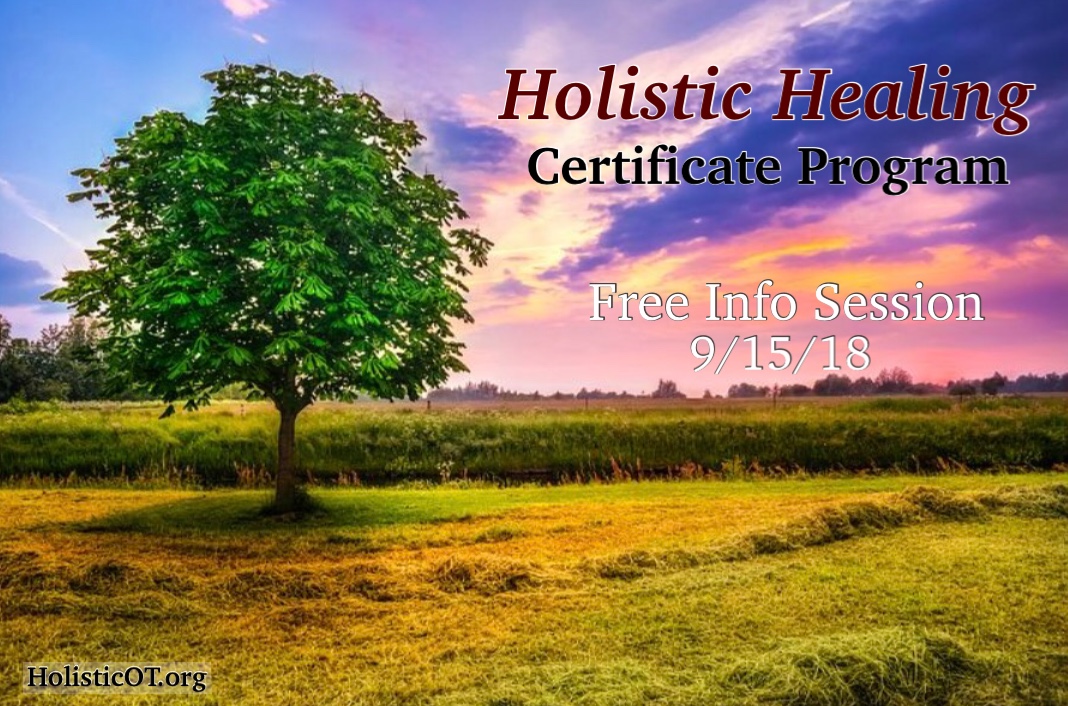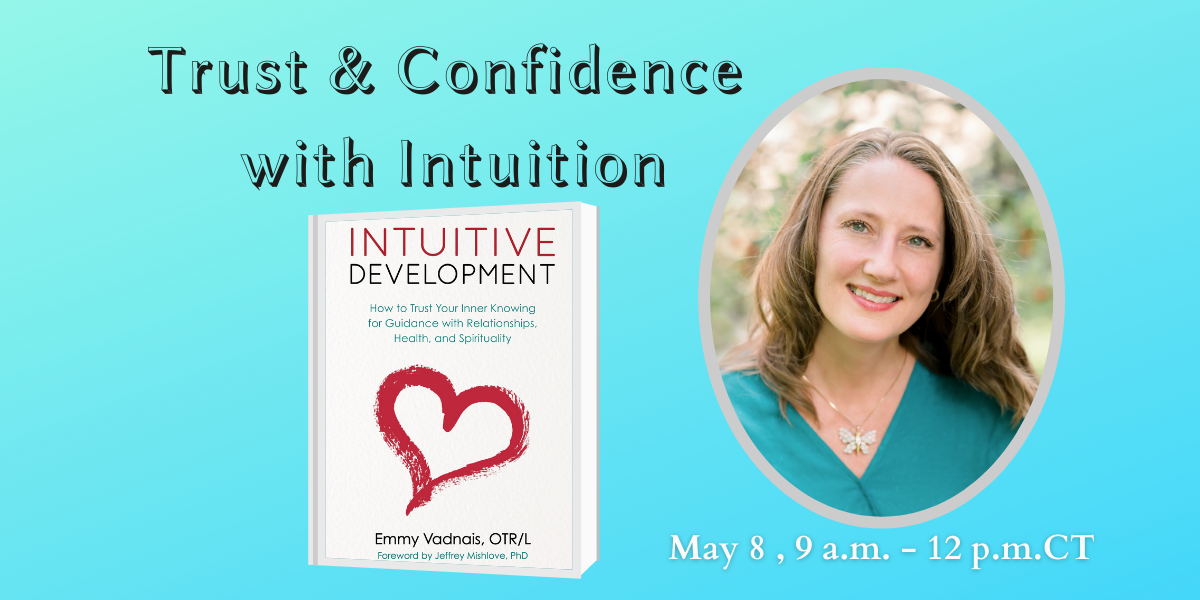
What is Guided Imagery?
 Here is an article I wrote for ADVANCE Magazine for Occupational Therapy Practitioners that shares what Guided Imagery is. If you are interested in learning Guided Imagery I have upcoming courses in local and distant learning formats this September listed Here. If you would like a private one to one session contact me at [email protected].
Here is an article I wrote for ADVANCE Magazine for Occupational Therapy Practitioners that shares what Guided Imagery is. If you are interested in learning Guided Imagery I have upcoming courses in local and distant learning formats this September listed Here. If you would like a private one to one session contact me at [email protected].
What is Guided Imagery? OTs can tap a person’s inner wisdom for health, healing and wellness.
By Emmy Vadnais, OTR/L
| Guided imagery is a mind-body-spirit healing approach that is expanding in to mainstream health care as research continues to demonstrate its powerful healing effects. Guided imagery bridges the communication between the mind, the body, and the spirit. It can assist to heal physical, emotional, mental and spiritual disharmony. It occurs in a relaxed, meditative state, and may also be referred to as creative visualization, mental imagery, therapeutic imagery, interactive guided imagery, guided meditation, active imagination, or intuition. OTs can easily integrate guided imagery into their practice to help clients navigate their lives more easily and confidently with improved health and well-being.Benefits of Guided Imagery Research shows that guided imagery can give a person a greater sense of control, increase self confidence, assist with fear, panic, anxiety, helplessness, uncertainty, trauma, loss, and grief, increase relaxation, decrease depression, decrease stress, decrease pain, decrease nausea, decrease blood pressure, prepare for medical procedures, decrease respiratory difficulties, decrease medication side effects, improve immune system, improve healing and recovery time, decrease hospital length of stay, enhance sleep, strengthen connection to spirituality, meaning, and purpose in life, improve functional outcomes, and improve quality of life.A key component in guided imagery is that it can help you and your clients connect to your inner wisdom; intuition that can guide you in ways that are not always accessible in normal waking states. It can help get to the root of what is behind a particular challenge. This may allow for creative insights, understandings, and awareness of solutions to the most burdensome of problems. It makes the subconscious more conscious. The more conscious and aware one is, the less suffering they may experience. Often, an image can convey a meaning or symbolism far greater than we can describe in words. Before we learned verbal language we perceived the world with all of our senses and saw in images or pictures. Carl Jung, who created his own form of guided imagery, called active imagination, stated, “When you concentrate on a mental picture it begins to stir, the image becomes enriched by details. It moves and develops, and so when we concentrate on inner pictures and we are careful not to interrupt the natural flow of events, our unconscious will produce a series of images that makes a complete story.” Healing with All of Our Senses This is the main premise in the field of psychoneuroimmunology — how thoughts, feelings, emotions, and beliefs affect the body, and the nervous and immune systems. When we experience prolonged stress or tension we are more at risk for being unwell as our immune systems can be compromised, and certain areas of our being may be negatively affected. Guided imagery allows access to the subconscious that is underneath all of our actions, drives, dreams, and physical, mental, emotional, and spiritual limitations and freedoms. Guided imagery interacts with the interplay of the mind-body-spirit connection to create positive outcomes for health on all levels of our being. Types of Guided Imagery
There are many other guided imagery techniques that can bring about healing and transformation such as dialoguing with body, creating inner strength and confidence, working with emotions, transforming energy, end result or ideal outcome, and mindfully learning to accept and love oneself with compassion and forgiveness. These are tools clients can then learn how to do on their own. Imagery is more client-centered and allows the person to access their own inner wisdom for guidance. They can learn to work with their intuition to assist them in all aspects of their lives. Guided Imagery Experiences Years later, while working at Abbott Northwestern Hospital at the Penny George Institute for Health and Healing as an integrative medicine practitioner in Minneapolis, MN, our team received training in guided imagery. We often used it to help people with pain, anxiety and expedite healing and recovery. We worked with the most challenging cases where people were not responding to pain or anxiety medications. Guided imagery often assisted the patients to relax, feel less pain, and recover more quickly. Recently, I helped a person who was experiencing foot and ankle pain that was limiting her mobility and enjoyment in life, and she was facing foot surgery. She was overweight and was upset she wasn’t disciplined to improve her nutrition and engage in her yoga practice. During her guided imagery session she discovered that the pain in her foot and ankle was represented by a heavy weight. The heavy weight was linked to all of the responsibilities in her life and recent stress and challenges with a teenage son who was involved with drugs a year previously. She also discovered she had unresolved grief related to her mother’s death. She allowed her feelings to flow through her and cried during the session. She learned that it is okay for her to feel her feelings and to take care of herself better. Six months later she was eating better, was participating in her daily yoga practice, lost 20 pounds, was more loving and compassionate toward herself, and enjoying life. Resources To connect with other OTs interested in and practicing holistic approaches and to learn more, join us once a month for our holistic OT phone conversation. Ask to join the e-mail list at [email protected] to receive updates on Holistic OT. Please ‘like’ our Holistic Occupational Therapy Facebook Page and join the conversation online at the Holistic Occupational Therapy Group page on Facebook. We look forward to connecting with you! Emmy Vadnais teaches and practices guided imagery and several other holistic-mind, body, spirit healing techniques. She is in private practice in St. Paul, MN, and teaches health care professionals how to integrate these approaches in to their practices. She can be reached at [email protected] or www.emmyvadnais.com. Chodrow, J. (1997) Jung on Active Imagination. Princeton, NJ: Princeton University Press. Guided Imagery. Retrieved from http://my.clevelandclinic.org/departments/integrativemedicine/guided_imagery_facts.aspx |

 “Working with an Image” is the most fundamental and powerful aspect of imagery work. An image can represent the problem, the solution, illness/disease, symptom, relationship, emotion, feeling, physical sensation, or pain. In a relaxed state, an image forms that represents the issue being addressed. While using all five senses the client interacts with the image. This gives the individual another perspective or deeper understanding on what it is the image represents for them. This can bring forth meaningful insight, guidance, direction, transformation, and healing. “A Special Place” is where a person imagines being in a special place, a healing place, or a relaxing place. This can have profound effects on shifting moods, biochemistry, and the physiology of a person. It often lowers stress, anxiety, pain, assists insomnia, and improves an outlook on life. It can take only 10 – 15 minutes for this to occur. The “inner wisdom”, “inner healer” or connecting to “spiritual support” techniques are wonderful for helping a person make decisions, make sense of what is happening in life, receive guidance on how best to move forward, and feel more peaceful.
“Working with an Image” is the most fundamental and powerful aspect of imagery work. An image can represent the problem, the solution, illness/disease, symptom, relationship, emotion, feeling, physical sensation, or pain. In a relaxed state, an image forms that represents the issue being addressed. While using all five senses the client interacts with the image. This gives the individual another perspective or deeper understanding on what it is the image represents for them. This can bring forth meaningful insight, guidance, direction, transformation, and healing. “A Special Place” is where a person imagines being in a special place, a healing place, or a relaxing place. This can have profound effects on shifting moods, biochemistry, and the physiology of a person. It often lowers stress, anxiety, pain, assists insomnia, and improves an outlook on life. It can take only 10 – 15 minutes for this to occur. The “inner wisdom”, “inner healer” or connecting to “spiritual support” techniques are wonderful for helping a person make decisions, make sense of what is happening in life, receive guidance on how best to move forward, and feel more peaceful.

